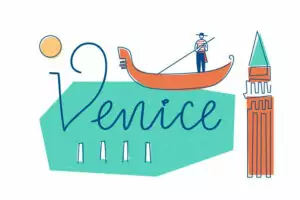When it comes to expressing ourselves through language, colors play a crucial role. They evoke emotions, set the mood, and add a touch of beauty to our surroundings. If you’re interested in learning the names and pronunciation of colors in Italian, you’ve come to the right place. In this article, we will explore the fascinating world of Italian colors, providing you with a handy guide to expand your language skills and enrich your cultural understanding.

✅ AI Essay Writer ✅ AI Detector ✅ Plagchecker ✅ Paraphraser
✅ Summarizer ✅ Citation Generator
How to Name Colors in Italian
To begin our journey into the world of Italian colors, let’s first explore the names used to describe them. The Italian language offers a beautiful array of colors that can add depth and flair to your conversations.
Here are some of the key color words along with their English translations:
Rosso (Red): The color of passion and energy, “rosso” can be used to describe anything from a vibrant red rose (rosa rossa) to a bold red lipstick (rossetto rosso).
Arancione (Orange): Evoking warmth and enthusiasm, “arancione” can be seen in the vivid hues of a sunset (tramonto arancione) or the vibrant skin of an orange (arancia arancione).
Giallo (Yellow): Symbolizing sunshine and happiness, “giallo” can describe the radiant color of a daffodil (narciso giallo) or the golden rays of a summer day (giornata gialla).
Verde (Green): Associated with nature and freshness, “verde” captures the color of lush foliage (fogliame verde) or the emerald hues of the Mediterranean Sea (mare verde).
Blu (Blue): Representing tranquility and serenity, “blu” can be found in the clear skies (cielo blu) or the vast expanse of the ocean (mare blu).
Azzurro (Light Blue): A shade reminiscent of a cloudless sky, “azzurro” brings to mind the gentle tones of a calm sea (mare azzurro) or the delicate petals of a forget-me-not flower (fiore azzurro).
Blu Scuro (Dark Blue): Reflecting depth and mystery, “blu scuro” can be observed in the shades of a starry night sky (cielo blu scuro) or the rich tones of a sapphire gemstone (zaffiro blu scuro).
Viola (Purple): Symbolizing royalty and elegance, “viola” adorns majestic flowers (fiore viola) and enriches the hues of a regal sunset (tramonto viola).
Rosa (Pink): Representing tenderness and femininity, “rosa” can describe delicate blossoms (fiori rosa) or the blush of a rosy-cheeked child (bambino rosa).
Marrone (Brown): Conveying earthiness and warmth, “marrone” can be seen in the shades of autumn leaves (foglie marroni) or the richness of dark chocolate (cioccolato marrone).
Nero (Black): Embodying mystery and elegance, “nero” is the color of the night sky (cielo nero) and the sleekness of a black panther (pantera nera).
Bianco (White): Symbolizing purity and innocence, “bianco” can describe the color of fresh snow (neve bianca) or the pristine feathers of a white dove (colomba bianca).
Pronouncing Colors in Italian
Now that we have acquainted ourselves with the names of Italian colors, let’s delve into their pronunciation. To help you accurately articulate these vibrant hues, here is a brief guide to pronouncing some key color words:
Rosso (Red): Pronounced as “ROS-soh.”
Arancione (Orange): Pronounced as “ah-ran-CHEE-o-neh.”
Giallo (Yellow): Pronounced as “JEE-al-loh.”
Verde (Green): Pronounced as “VER-deh.”
Blu (Blue): Pronounced as “BLOO.”
Azzurro (Light Blue): Pronounced as “at-TSOO-roh.”
Blu Scuro (Dark Blue): Pronounced as “BLOO SKOO-roh.”
Viola (Purple): Pronounced as “vee-OH-lah.”
Rosa (Pink): Pronounced as “ROH-zah.”
Marrone (Brown): Pronounced as “mar-ROH-neh.”
Nero (Black): Pronounced as “NEH-roh.”
Bianco (White): Pronounced as “BEE-ahn-koh.”
Usage and Agreement of Color Words
In Italian, the usage of color words can vary depending on the gender and number of the noun they describe. It is important to keep these agreements in mind to ensure accurate communication. Here are some examples:
Il gatto rosso (The red cat): In this example, “rosso” agrees with the masculine singular noun “gatto.”
La macchina rossa (The red car): Here, “rossa” agrees with the feminine singular noun “macchina.”
I fiori rossi (The red flowers): In this case, “rossi” agrees with the masculine plural noun “fiori.”
Le rose rosse (The red roses): In this example, “rosse” agrees with the feminine plural noun “rose.”
Examples
- Il sole è giallo. (The sun is yellow.)
- Ho una maglietta verde. (I have a green t-shirt.)
- Mi piace il cielo azzurro. (I like the blue sky.)
- La rosa è rosa. (The rose is pink.)
- La cioccolata è marrone. (The chocolate is brown.)
- La neve è bianca. (The snow is white.)
- L’inchiostro è nero. (The ink is black.)
- Il tramonto è arancione. (The sunset is orange.)
- Il viola è un colore bello. (Purple is a beautiful color.)
- Ho gli occhi verdi. (I have green eyes.)
- Ho un cappello blu. (I have a blue hat.)
- La banana è gialla. (The banana is yellow.)
- La lavagna è verde. (The chalkboard is green.)
- Il mare è blu. (The sea is blue.)
- Mi piacciono le rose rosse. (I like red roses.)
- Ho un cane bianco. (I have a white dog.)
- Il cielo di notte è nero. (The night sky is black.)
- I fiori viola sono bellissimi. (Purple flowers are beautiful.)
- La farfalla è arancione. (The butterfly is orange.)
- La terra è marrone. (The earth is brown.)
- L’abito da sposa è bianco. (The wedding dress is white.)
- Ho trovato un uovo blu. (I found a blue egg.)
- Il limone è giallo e acido. (The lemon is yellow and sour.)
- La macchina è rossa. (The car is red.)
- I pomodori sono rossi. (The tomatoes are red.)
- Il sole tramonta arancione. (The sun sets orange.)
- Ho una penna nera. (I have a black pen.)
- Il cielo invernale è grigio. (The winter sky is gray.)
- La nebbia è bianca e densa. (The fog is white and dense.)
- La rosa profumata è rosa chiaro. (The scented rose is light pink.)
Enhancing Your Language Skills
To deepen your understanding of Italian colors and expand your language skills, consider exploring additional resources such as language learning apps, online courses, or engaging with native speakers. Immersing yourself in the Italian language will not only enable you to confidently name and pronounce colors but also open doors to a rich cultural experience.
FAQ
Why is it useful to learn the colors in Italian?
Learning the colors in Italian is useful because it allows you to effectively communicate and describe the world around you. Colors play a significant role in everyday conversations, from discussing your favorite clothing items to describing the beauty of nature or expressing your preferences.
How are color words typically used in Italian sentences?
In Italian, color words often come after the noun they describe. For example, instead of saying “red car,” you would say “car red” (macchina rossa). However, there are exceptions to this rule. Color words like “light blue” (azzurro) are used before the noun. Additionally, the color word must agree with the gender and number of the noun it describes.
Do color words in Italian change based on gender and number?
Yes, color words in Italian change based on the gender and number of the noun they describe. For example, “rosso” (red) changes to “rossa” for a singular feminine noun, “rossi” for a masculine plural noun, and “rosse” for a feminine plural noun. It is important to pay attention to the gender and number of the noun to ensure correct agreement with the color word.
Are there any color words in Italian that do not change regardless of gender or number?
Yes, there are color words in Italian that do not change regardless of gender or number. Some examples include “blu” (blue) and “arancione” (orange). These color words remain the same for both masculine and feminine nouns, as well as for singular and plural nouns.
Follow us on Reddit for more insights and updates.





Comments (0)
Welcome to A*Help comments!
We’re all about debate and discussion at A*Help.
We value the diverse opinions of users, so you may find points of view that you don’t agree with. And that’s cool. However, there are certain things we’re not OK with: attempts to manipulate our data in any way, for example, or the posting of discriminative, offensive, hateful, or disparaging material.